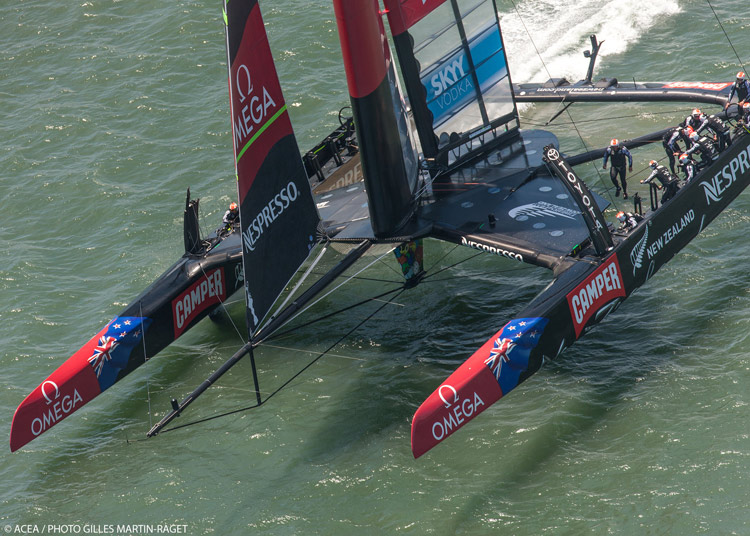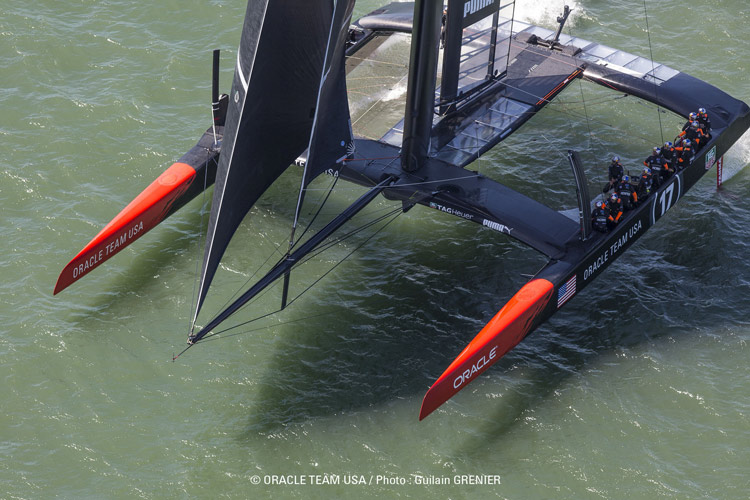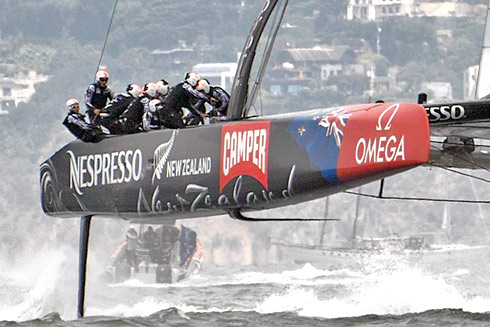Evolutionary Optimization of AC72 Catamarans
Andrew Mason Talks about Oracle Team USA's Approach to
Faster Multihulls
August 1, 2013
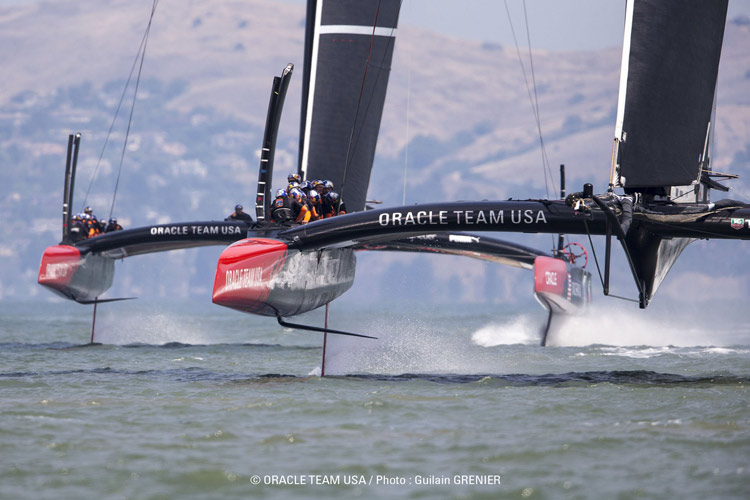
Oracle AC72 #2 in front, #1 behind.
Photo:©2013 Oracle Team USA/Guilain Grenier
For the 2013 America's Cup, Andrew Mason worked for Oracle Team USA on the optimization of their two AC72 Class catamarans using evolutionary modeling techniques to test design possibilities and "breed" faster yachts. His work for Oracle built on the innovative analysis of America's Cup Class monohulls he brought to Alinghi's successful defense of the Cup in 2007, which he explained in detail in this earlier article at CupInfo.
Here Andrew explains how these advanced methods were adapted to the creation of large, foiling, wing-sail multihulls for the America's Cup; the thinking behind critical design decisions; and how this effort literally shaped the defending yachts:
|
|
|
|
Oracle Team USA AC72 #2. |
Q: How did you get involved with the Oracle team and what role did you play in the design of Oracle’s AC72’s?
I had worked with both Manolo Ruiz de Elvira and Mike Drummond at Alinghi prior to 2007 and I approached them in early 2011 regarding the optimization of Oracle’s hull designs. As a result of their support for the project I was contracted to the Oracle Racing design team from May 2011 to August 2012 to perform optimization of the hull shapes of the two Oracle AC72s.
The optimization group comprised myself, Manolo, Joseph Ozanne and
Michel Kermarec. Manolo provided the parent designs and performed the
computational fluid dynamics (CFD) analysis, Joseph provided the
velocity prediction program (VPP) and continually refined it during
the project, and Michel helped define which parameters were varied and
provided a sanity check on the outputs from the optimizer.
What methods did you use for optimization?
These were similar to those used at Alinghi for the 2007 Cup, an
evolutionary optimizer linked to a VPP and a race modeling program
which ran thousands of races between each pair of designs modeled. The VPP used Neural Network-based regression models for lift, drag,
and other parameters, and these were derived from CFD results for a
large number of parent design variations. The resulting models were
capable of producing quite accurate lift and drag values for any
design within the design space we had defined.
Did the optimization project have a blank sheet of paper within the confines of the AC72 Class Rule, or were there some fundamental design decisions taken before beginning the process?
By the time the optimization project commenced Manolo had already been developing AC72 hulls for several months, so we started with quite a refined parent design. From there we had to decide the limits on how far the optimizer could modify the parent design before it became impractical or risky for other reasons. These risks included undesirable or unquantifiable effects on seakeeping or maneuvering, as well as the possibility that the CFD may not accurately calculate the effect of extreme hull features. So for example, we imposed limits on minimum and maximum beam, transom immersion and longitudinal center of buoyancy position, to name a few. In the end we had about 10 hull shape parameters that we were varying, and we explored all of that 10 dimensional design space.
For boat 2 we relaxed a few of the limits and locked other parameters
where we were confident that we had close to optimal values.
This reduced the dimensionality of the design space making the
optimization process for boat 2 a little more efficient.
How did you perform race modeling when for a long period the details of the racecourses were not confirmed?
The courses had not been defined at the time optimization work started for boat 1, so we simply assumed a 50:50 split for upwind:downwind sailing. This was considered a reasonable assumption at the time given our expectations for the venue.
By the time the courses had been defined, it was clear that the boats
would be fully foiling downwind in all but light weather, and
consequently we only needed to optimize for upwind performance.
In this case the course design did not affect the optimization process
at all.
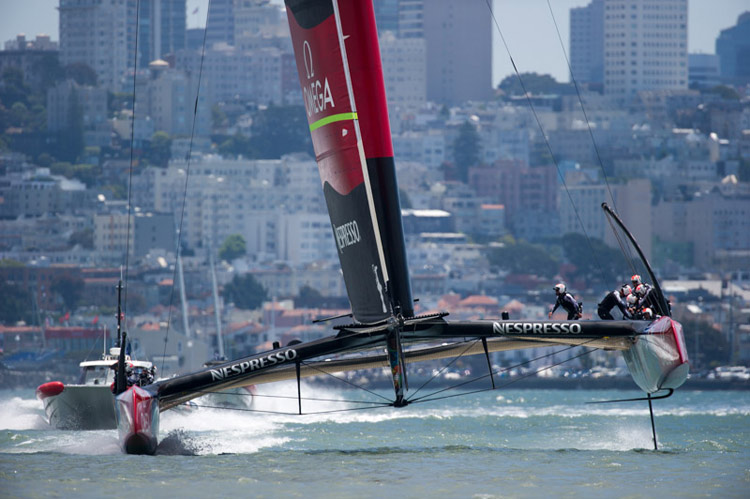
Emirates Team New Zealand Boat #2. Photo:©2013
Chris Cameron/ETNZ
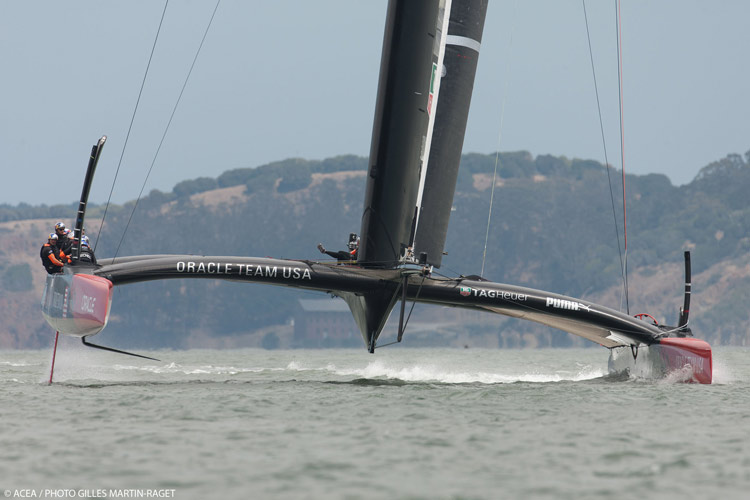
Oracle Team USA boat #2. Photo:©2013 ACEA/Gilles
Martin-Raget
Given the apparent wind speeds involved, was the aerodynamic performance of the platform an aspect of the optimization model, evolved genetically, too?
No, we didn’t vary the platform aerodynamics or wing design during
each hull design optimization phase, as this would have introduced
additional variables that would have clouded the results. The
hull shape optimization project took place quite late in the design
process, and by this stage the major aerodynamic characteristics of
the platform and wing had already been investigated in some detail.
We used aero models based on the characteristics of the preferred rig
and platform, so it is more accurate to say that the hulls were
optimized based on the rest of the package.
There has been a lot of discussion about the extent to which Oracle’s first boat was intended to foil. Can you clarify whether Oracle boat 1 was designed as a non-foiling boat?
It was clear while boat 1 was being designed that some measure of foiling was possible. We were confident that the boats would not foil upwind, but whether the boats would foil some of the time or all of the time downwind was not clear. As a result, boat 1 was designed to cover a range of possible outcomes, with the hull shape being optimized for the entire speed range.
By the time we got to boat 2, it was clear that the boats would be
foiling most of the time downwind, and this resulted in the hull shape
of boat 2 effectively being optimized for upwind work, as the hulls
would seldom touch the water downwind. This means that the two
hulls were effectively optimized for different speed ranges; hull 1
had to perform efficiently up to very high speeds, whereas hull 2
would only be immersed at speeds below about 25 knots.
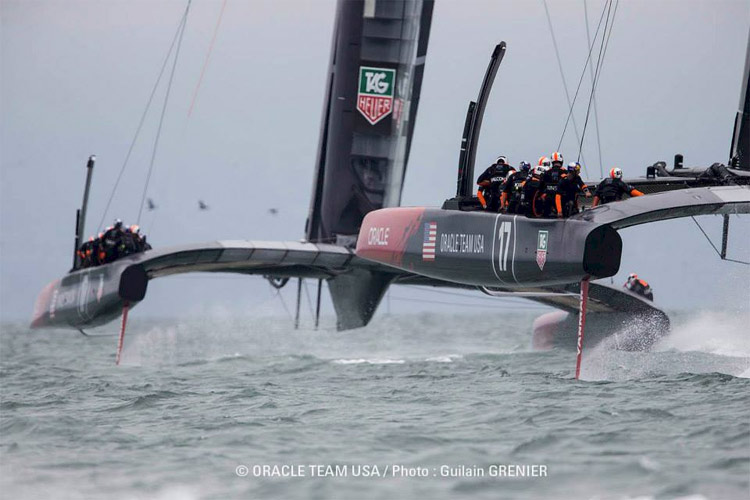
Oracle AC72 #1 in the lead, at left, AC72 #2 at right. Photo: ©2013
Oracle Team USA/Guilain Grenier
Although superficially similar, the two hull shapes have some
significant differences. Some of these differences were due to
the different speed ranges and levels of immersion that the hulls were
expected to encounter, while some were simply that the design team
became more comfortable with relaxing limits for some design
parameters that the optimizer had been exploring.
Why are differences in hull shapes important at all, surely the hulls are going to be out of the water for the majority of each race?
I think many people have underestimated the importance of having a fast boat in non-foiling mode – certainly if you were basing your opinions on the videos of the various teams training, you would incorrectly assume that the AC72s are airborne 95% of the time. The reality is that non-foiling performance is going to be an important factor in winning races.
For the AC72, upwind speed made good (VMG) is about half of downwind VMG. Even though there are more downwind legs than upwind legs, the slower upwind speeds mean that 50% to 65% of the race time will be spent on upwind sailing in non-foiling mode.
While an AC72 can foil by pulling
away 10-15 degrees from its best upwind sailing angle, the increase in
boat speed is not sufficient to produce better VMG. I suspect that it
is the aerodynamic efficiency of the wing that makes it preferable not
to foil upwind as the superior lift to drag ratio of the wing allows
the boats to be fast at quite narrow true wind angles. I think that
it’s quite possible that if the AC72 had been designed to use soft
sails instead of a wing, the lower rig efficiency might have resulted
in foiling at broader angles being the fastest mode for upwind legs.
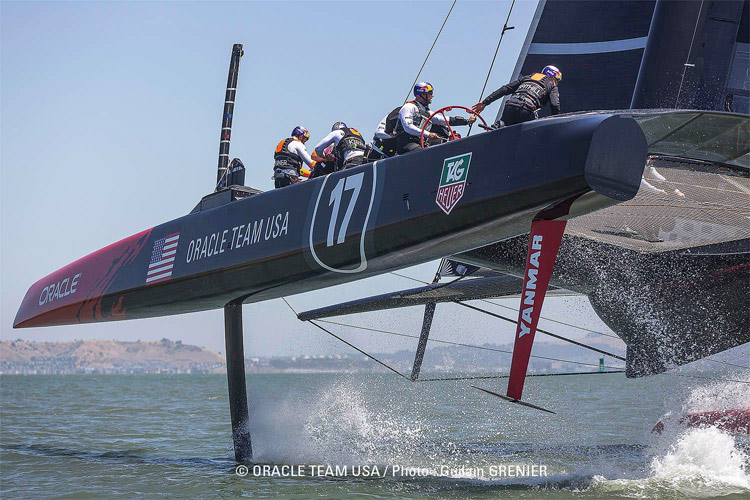
Oracle Boat #2. Photo: ©2013 Oracle Team USA/Guilain Grenier
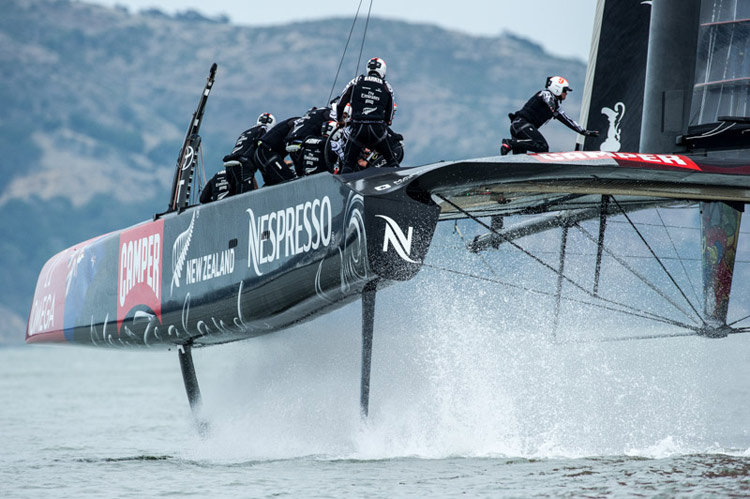
ETNZ Boat #2. Photo: ©2013
Chris Cameron/ETNZ
The Oracle hull shapes are different than those chosen by ETNZ. Can you comment on the logic behind these differences?
The Oracle hull shapes have clearly been optimized to be as slippery as possible upwind while having an adequate safety margin downwind. The hulls are fine, with quite rounded sections amidships and forward, while still retaining quite powerful stern sections. The optimizer was clearly happy to have the hulls contribute very little dynamic lift, preferring to use the main foil to provide this lift in the most efficient manner. The result is a hull shape that is low drag when immersed, and continues to have very low drag as the main foil generates more lift and the effective displacement of the hull reduces. This gives a design that minimizes the incremental drag as the boat lifts clear or re-enters the water in marginal foiling conditions or while maneuvering.
In contrast the ETNZ hulls appear to have relatively flat sections along the length of the boat, and these will contribute some dynamic lift as the hull speed increases. However, in my view the generation of this dynamic lift is relatively inefficient and will incur a drag penalty. In particular I feel that these sections will not be as efficient when sailing upwind, particularly in fresh conditions when the main foil is generating enough lift to significantly decrease the displacement of the hull. In these conditions the flatter sections will not reduce their wetted surface area as effectively as the narrower, rounder sections of the Oracle boats, resulting in higher overall drag.
As a result, it would not
surprise me if the Oracle boats are superior to ETNZ upwind,
particularly considering the attention that has been paid to the
aerodynamics of the Oracle platforms. The combination of low
hydrodynamic and aerodynamic drag should result in an advantage for
Oracle on the windward legs.
Could you provide a little more explanation of dynamic lift via the hull shape?
A hull shape that is reasonably flat will generate some dynamic lift as the hull speed increases. This will result in the boat rising slightly until it finds a new equilibrium between its weight and the sum of its buoyant lift and its dynamic lift. If the boat is flat enough and the speed fast enough, the magnitude of the dynamic lift will allow the hull to rise up and plane across the water. Lesser amounts of lift may not produce actual planing, but may result in a significant reduction in displacement. Whether the resulting reduction in wetted surface area and wave-making resistance is greater than or less than the induced drag resulting from the generation of the dynamic lift depends on many factors.
It is possible for the forward sections of the hull to generate dynamic lift, while positive curvature in the run aft may generate down-force. In this case the net lift may be negligible, but a significant trimming moment by the stern may have been generated, resulting in the hull squatting at high speed. This is undesirable, as is the opposite case of powerful stern sections generating more lift than fine bow sections, resulting in bow-down trim at speed.
One of the things we were able to
do during the optimization process was constrain for minimal changes
in trim throughout the speed and displacement ranges. Trim changes at
different speeds are undesirable in general, but for a foiling hull
they can potentially change the angle of attack of the main lifting
foil, so this was a useful side-effect of the optimization process.
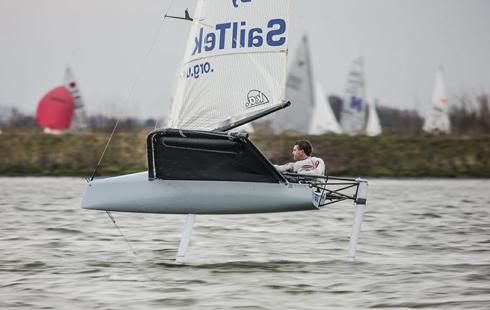 |
|
|
The Exocet foiling Moth. Photo: ©2013
Maguire Boats/Simon Maguire |
|
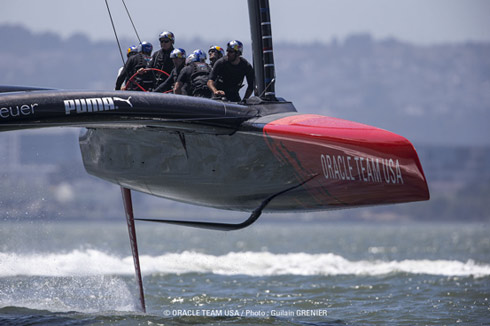 |
|
|
Oracle boat #2. Photo:©2013 Oracle Team USA/Guilain Grenier |
For a hull without lifting foils, flat sections may be the best route to high performance if the boat is sufficiently light and has sufficient propulsive force. For a boat that has lifting foils, lift may be more efficiently generated by a high-aspect-ratio, immersed foil than it could by a low-aspect-ratio (i.e. long and narrow) hull surface. The optimizer appears to concur with this view, clearly favoring rounded, low-wetted-surface-area hull shapes over the flatter sections adopted by ETNZ.
Some would argue that this view is contradicted by trends in classes such as the F18 and A-Class catamarans, and the International Moth. The F18 and A-Class cats have both seen a trend to wider, flatter hulls in recent years. However, this occurred prior to the successful use of efficient lifting foils. I would not be surprised if, once full foiling becomes more commonplace in these classes, a trend back to more conventional displacement-type hulls occurs.
For the International Moth, certainly the class that has done the most foiling over the past 10 years, designers have favored quite flat sections throughout the length of the hull since foiling was first introduced in the class. However, it is interesting to see that some of the more recent designs, such as the British Exocet, have adopted rounded, low-lift, low-wetted-surface-area sections. The Exocet has been highly successful, filling the top 5 places at the recent European Championships and 7 of the top 10 in the U.K. Nationals.
What are the limitations of the optimization approach taken for this project?
All computer simulations are limited by the assumptions and simplifications they make. It is essential to validate and verify the methods used to ensure that results are accurate simulations of reality. In the case of the optimization project at Oracle we were dependent on numerical simulations at two different levels, CFD analysis of hull shapes and VPP analysis of the performance of a particular boat configuration. CFD programs for hull analysis are now quite mature systems, but a trade-off still exists between systems having high performance with questionable accuracy, versus those having excruciatingly slow performance but high accuracy. At Oracle we used a combination of CFD systems, and were comfortable with the approach adopted. Great pains were taken to carefully validate the predictions made by the optimizer using detailed CFD analysis of the optimized hull shapes.
While the programming of a VPP for low-speed, displacement yachts is not a difficult problem, the design and implementation of a VPP for high-speed craft is another matter. In particular, high-speed craft may have multiple equilibria, or modes, in their performance. Determining whether a step from one mode to another is possible is not always easy.
|
|
|
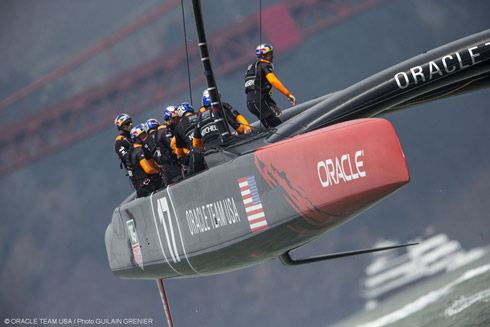 |
|
| Photo:©2013 Oracle Team USA/Guilain Grenier |
A simple example of this is a lightweight dinghy in marginal planing conditions. The boat may be stuck in non-planing mode until a small amount of additional energy in added to the system, such as a small gust, a pump of the mainsheet or picking up a small wave. Any of these may be enough to get the boat on the plane, resulting in lower hull resistance and higher apparent wind speed that is sufficient to keep the boat planing in conditions identical to those in which it was formerly stuck in displacement mode.
For high-speed foiling catamarans there may be several modes available at any given time, but determining which of those is the fastest achievable for any given wind strength and direction is a non-trivial problem.
Fortunately we had access to Joseph Ozanne and his VPP, which has been developed and improved over several years, including its use in the design of USA 17, the Oracle trimaran which won the 2010 America’s Cup. Joseph refined the VPP continuously during the optimization project, validating it initially against the performance of the AC45, both with and without lifting foils. As a result we had a great deal of confidence in its accuracy.
What do you see for the future of optimization methods in yacht design, and particularly the America’s Cup?
I think we have barely scratched the
surface so far. One limiting factor has been the availability of
accurate CFD analysis at reasonable cost. This is still an issue, but
the continuous gains in the performance/price ratio of computer
hardware improve this situation each year.
Thanks Andrew!
--©2013 CupInfo.com/Andrew Mason
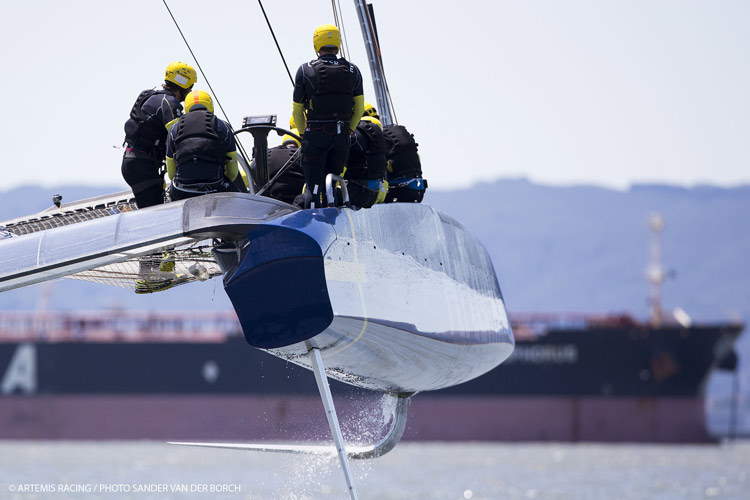
The hull of Artemis Racing's foiling AC72, their second boat, more
closely resembles the Oracle #2 hull shape.
Photo:©2013 Sander van der Borch/Artemis Racing
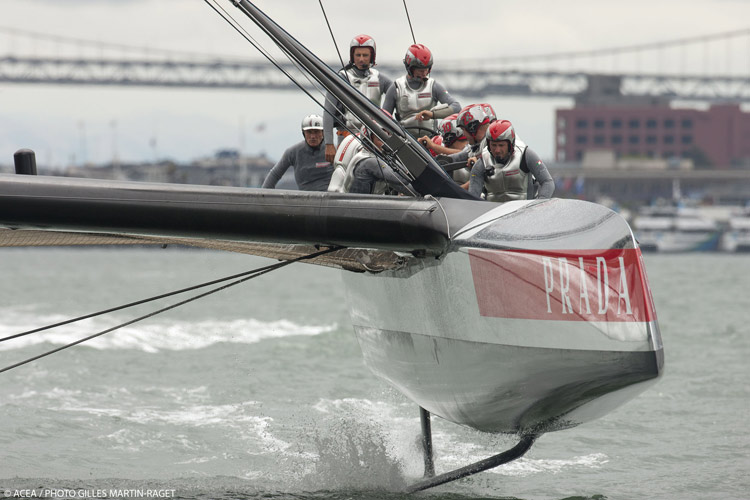
Luna Rossa's single AC72 shares her hull shape with ETNZ's boat #1.
Photo:©2013 ACEA/Gilles
Martin-Raget
Links of Interest:
Do you want to learn more about
Evolutionary Optimization in yacht design?
Andrew Mason explains the principles of Evolutionary Optimization of
America's Cup Class yachts in detail in this 2011 article at CupInfo,
including the role the analysis played in the 2007 America's Cup, and
how the techniques might be adapted to multihulls. Also included
is a guide to some of the technical terms and concepts, and links to
Andrew's technical writings which present the subject at a
professional level.
Read
Article "Optimizing America's Cup Yachts with Andrew Mason: Genetic Modeling Advances America's Cup
Performance" at CupInfo
